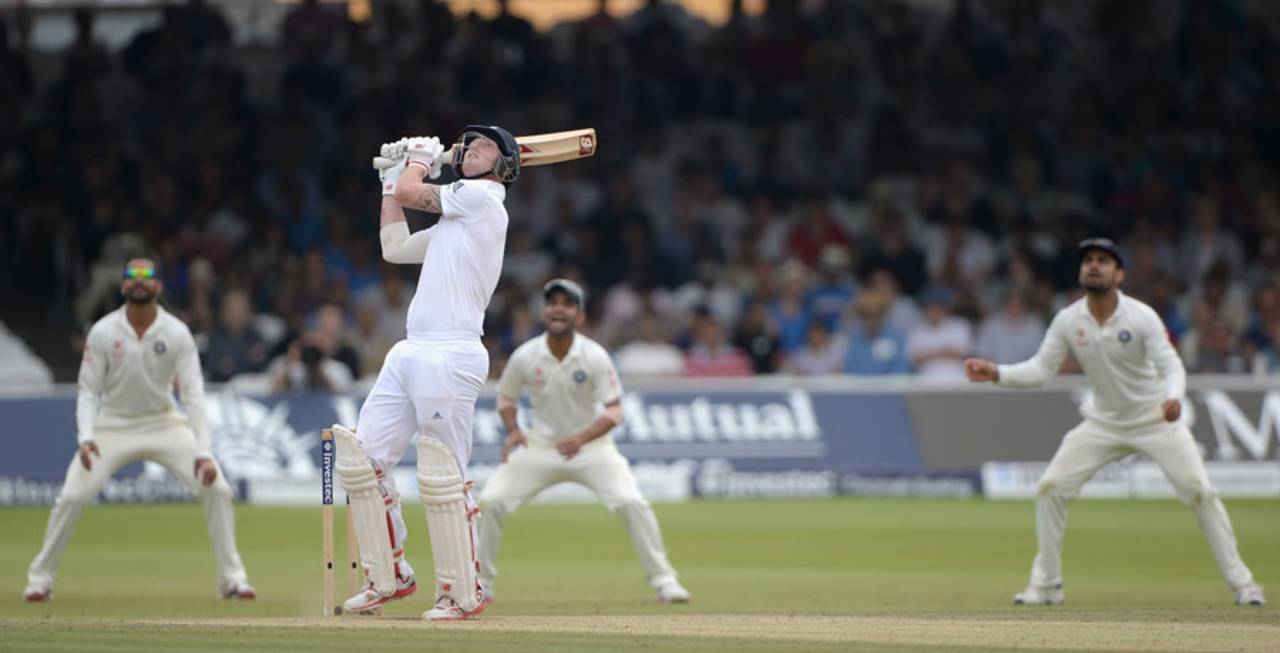The reason for England's loss? T20, of course
In this day and age no one appreciates the art of ducking against a short ball
Andrew Hughes
23-Jul-2014

"I've always believed that the sky's the limit" • Getty Images
First Mitchell Johnson and now Ishant Sharma. The phenomenon of a much-ridiculed fast bowler returning to kick English bottoms, like a bullied schoolboy who has spent the intervening years in the Temple Of Hurt learning Kung Fu Chin Music under Master Holding and Master Lillee, before returning to wreak vengeance and to reclaim his lunch money with interest, is becoming commonplace.
Monday's comeuppance was delivered by Ishant in concert with Mahendra Singh Jardine, but whereas Jardine spent months planning his brutal assault on the Australians of 1932, Dhoni just threw the ball to the big man and told him to try a few short 'uns. Then again, there are no Don Bradmans in this England team. There are no Vic Richardsons, Stan McCabes, Bill Ponsfords or Bill Woodfulls either.
This wasn't bodyline (a ruthless targeting of the batsman's body) it was Stupidity Line, a ruthless targeting of the English weakness: the bit between their ears.
"More brains in a porkpie," declared the oracle of Yorkshire, which wasn't technically true, although had England replaced their lower-middle order with a succession of offal-and-pastry delicacies wheeled out on a dinner trolley, they couldn't have done any worse, and there would have been a considerable saving on wages.
But I don't blame the English batsmen. I blame T20. In days of yore (the 1980s) the really macho thing to do was not to play at the short ball. It demonstrated your fortitude, your resolve, your stiff upper lip. You only played at a short one if you were a) Viv Richards b) Ian Botham c) a terrified over-promoted county cricketer desperately trying to make the ball go away like a child at a picnic using a banana to fend off a wasp.
Entire rain delays were consumed by debates about taking on the short ball and the irresponsibility thereof. A man who did that sort of thing, unless he already had a double-century and his team was cruising to victory, was the sort of chap who'd make a salad for his guests without bothering to wash the vegetables, or park his car on double yellow lines while he popped into the shop to buy some cigarettes. He was an untrustworthy bounder, cad or dilettante, who needed to be locked in the stocks outside Lord's and pelted with limp cucumber sandwiches until he learned his lesson.
But in the T20 age, no one appreciates the art of swaying, ducking, or if you're Phil Tufnell, the art of throwing yourself flat on the ground and covering your head with your hands. In an era where games can be won with three lucky swipes, it makes no sense to decline the opportunity to lash at a short one. Unless, of course, you are playing in a Test match on the last day with 100 runs to get with four wickets left. Then it makes sense.
What the Indians don't realise is that they've woken a monster. They've prodded the school bully with a stick and ridiculed him in public. There will be a backlash. In the third Test, England's four angry seamers will steam in with one thing in mind: the re-establishment of the manliness of English cricket through bowling a leather ball at Indian heads, swearing and looking a bit cross.
Or at least they would have done, if they hadn't already tried that.
Instead, they are likely to fall back on a variation of plan B. This is an old favourite, last used in the 1980s when West Indies had some fast bowlers and England didn't. It involves a concerted whining campaign about the evils of short-pitched bowling (preferably illustrated by pictures of bruised English fingers); a petition to outlaw any delivery that rises above the knee; and above all, the introduction of a new playing regulation banning any bowler whose fringe exceeds two inches.
Andrew Hughes is a writer currently based in England. He tweets here